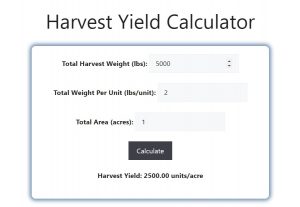About Harvest Yield Calculator (Formula)
The Harvest Yield Calculator is a vital tool for farmers, agricultural analysts, and anyone involved in crop production. It enables users to calculate the yield of their harvest, providing crucial insights into agricultural efficiency. By understanding yield, farmers can make informed decisions about crop management, resource allocation, and future planting strategies. This article will guide you through the formula used in the calculator, demonstrate how to use it, provide an example, and answer common questions about harvest yield.
Formula
The formula for calculating harvest yield is:
Harvest Yield = Total Harvest Weight / (Weight Per Unit * Total Area)
Where:
- Total Harvest Weight is the weight of the entire crop harvested, usually measured in tons or kilograms.
- Weight Per Unit is the average weight of a single unit of the crop (e.g., per plant or per bushel).
- Total Area refers to the area cultivated, typically measured in acres or hectares.
How to Use
- Gather Data: Collect the necessary information, including the total weight of the harvest, the weight per unit of the crop, and the total area cultivated.
- Input Values into the Formula: Substitute your values into the harvest yield formula.
- Calculate: Perform the calculations to determine the harvest yield.
Example
Let’s consider a practical example:
- Total Harvest Weight: 5000 kilograms
- Weight Per Unit: 2 kilograms (average weight of each crop unit)
- Total Area: 1 hectare
Step 1: Identify the Values
- Total Harvest Weight = 5000 kg
- Weight Per Unit = 2 kg
- Total Area = 1 hectare
Step 2: Plug Values into the Formula
Harvest Yield = 5000 kg / (2 kg * 1 hectare)
Step 3: Calculate
Harvest Yield = 5000 kg / 2 kg
Harvest Yield = 2500 units per hectare
In this example, the harvest yield is 2500 units per hectare.

FAQs
- What is harvest yield?
Harvest yield refers to the amount of crop produced per unit area, providing insight into agricultural productivity. - Why is calculating harvest yield important?
Calculating harvest yield helps farmers assess crop performance, optimize resources, and improve future planting strategies. - What units are used for harvest yield?
Harvest yield is typically expressed in units per area, such as units per hectare or units per acre. - How do I measure total harvest weight?
Total harvest weight can be measured using a scale or weighing system to determine the weight of the entire crop. - What does “weight per unit” mean?
Weight per unit is the average weight of a single crop unit, which helps in calculating overall yield. - How is total area measured?
Total area is measured in units such as acres or hectares, using tools like GPS or land surveying equipment. - Can this calculator be used for any crop type?
Yes, the harvest yield calculator can be used for various crops, including grains, fruits, and vegetables. - What factors can affect harvest yield?
Factors include soil quality, weather conditions, crop variety, and farming practices. - How can I improve my harvest yield?
Improving harvest yield can involve optimizing soil health, selecting high-yield crop varieties, and using effective pest management practices. - Is there a difference between gross and net yield?
Yes, gross yield refers to the total harvest weight, while net yield accounts for any losses during harvesting and processing. - How often should I calculate my harvest yield?
Calculating harvest yield after each harvest season helps track changes in productivity over time. - What tools can I use to gather harvest data?
You can use weighing scales, field measurement tools, and agricultural software to collect and analyze data. - Can I use this calculator for commercial farming?
Yes, the harvest yield calculator is particularly useful for commercial farming to assess production efficiency. - What is a good harvest yield?
A good harvest yield varies by crop type and local conditions. Research local benchmarks for comparison. - How can I use yield data to make decisions?
Analyzing yield data can help you make informed decisions about crop rotation, resource allocation, and market strategies. - Can this calculator help with budgeting?
Yes, understanding yield can inform budgeting decisions for inputs like seeds, fertilizers, and labor. - How does climate affect harvest yield?
Climate can significantly impact crop growth and yield, influencing factors such as temperature, rainfall, and sunlight. - Is there a seasonal variation in harvest yield?
Yes, harvest yields can vary seasonally due to differences in growing conditions and crop management practices. - What are the environmental impacts of high yield farming?
High yield farming can lead to increased resource use, potential soil degradation, and greater environmental impacts if not managed sustainably. - Can technology help improve harvest yield calculations?
Yes, technology such as precision agriculture tools and data analytics can enhance the accuracy and efficiency of yield calculations.
Conclusion
The Harvest Yield Calculator is an essential tool for farmers and agricultural professionals seeking to maximize productivity and efficiency. By understanding the formula for calculating harvest yield and how to apply it, users can gain valuable insights into their crop production. Regularly assessing harvest yield not only aids in making informed decisions but also contributes to sustainable agricultural practices. With the right data and tools, farmers can enhance their operations and work towards achieving higher yields year after year.
